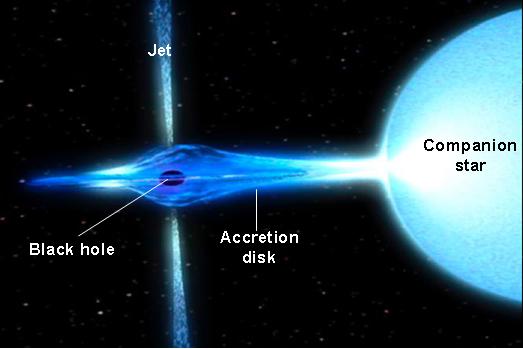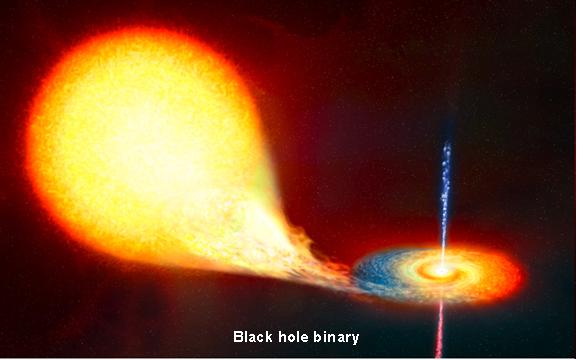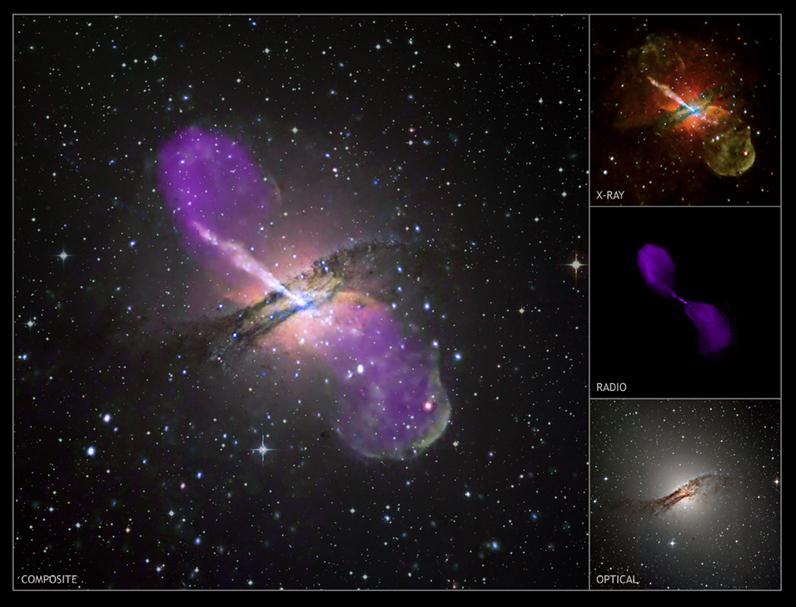| P10: Constraining Jet Physics and Formation |
 |
 |
 |
|
Dibi-Rousselle, Salomé
A very short story about stars life
Did you know that a star is like a human being in the sense that it is born one day and dies another? For a star, that would be after a lifetime of a millions or billion years, depending on its mass. Cosmological data tells us that our universe is around 14 billion years old, which is enough time for many generations of stars to have already evolved and played their part in the history of our universe. A star cannot be born just anywhere in the universe, indeed stars spend all their life inside a galaxy because their very existence and creation is dependent on the galaxy environment, just as humans need water and the Earth’s atmosphere. And, if we do someday find life somewhere else in the universe, it is strongly expected to be on another planet with an environment similar to Earth’s. The Sun is a star among a population of 400 billion stars living together in our Galaxy, the Milky Way. Our sun is a relatively small star, which is in the middle of its lifetime. In about 4 billion years, after burning all of its gases, consisting of mainly hydrogen and helium, the sun will begin to die. While the death of a heavy star can be a violent phenomenon involving a giant explosion called a supernova, our Sun is so small that it will only shed its outer layers into the environment as a nebula and leave a white dwarf remnant where its core used to be. The materials added to the interstellar medium will be eventually used later to form new stars. For more massive stars, their pull of gravity is so strong that the story is a little bit different. Gravitational force is driven by mass. The mass of the Earth attracts everything towards its center. As the moon rotates around the Earth, it creates a counterforce pulling away from the center of the Earth, compensating for the pull of gravitation force towards the Earth. If you wanted to throw a ball with enough strength to escape the pull of gravity so that the ball would not fall back to Earth, you would need to throw the ball so that it travels at a speed of 11.2 km/s, or 25,000 miles per hour! This is called the escape velocity. In the same way, the Earth is rotating around the Sun, which compensates for its strong attraction, and the Sun itself is rotating around the center of the Milky Way, which compensates for the gravitational pull of all the matter inside its rotation radius.
When a very massive star is dying, it explodes in a supernova, which is the only process in the universe in which elements higher than iron on the periodic table can be formed. This means that the copper in your blood or the calcium in your bones had to have originally been made in a supernova explosion! Some of the material near the core collapses inwards because of the strong gravitational attraction, which can be so strong that it compresses atoms to create a neutron star. A neutron star is so dense that it has an escape velocity of about 100,000 km/s or 223,700,000 miles per hour, and a single teaspoon of its material would have a mass over 5x1012 kg. The death of the most massive stars is even more dramatic. Their collapse is so forceful that it creates an object dense enough to have an escape velocity higher than the speed of light. The speed of light is c = 300,000 km/s, and it is the maximum velocity, as nothing can travel faster than light. In this case, what remains of the exploded star is called a black hole; indeed not even light can escape it. In fact, nothing can escape the pull of a black hole, and we are not able to detect it directly.
A very short story about stars "after-life" A black hole is thus a remnant of a very massive star that died after a violent collapse. We know that black holes exist because we can “weigh” them via their strong gravitational influence. They are not visible, but they attract everything towards themselves. The only way to “see” a black hole is to observe the material around it, which is either being pulled inside the hole, or in stable orbits around it similar to planets around our Sun. Although some black holes may be isolated (in which case we will never see them), in many cases they will have material available in their vicinity to accrete. A neighboring twin star that is still “alive” often provides this material. Indeed when stars are created, it is quite likely that 2 or more stars are born in the same area, and are bound to each other forever by gravitation. This is called a binary system. We have only one Sun in our Solar system, but at least 1/3 of the star systems in our Galaxy are binary or multiple systems.
Example of a binary star, where two bodies with similar mass orbit around a common barycenter in elliptic orbits. I am interested in the evolution of systems called black hole binaries, where one of the stars is already a black hole, and the other star is providing material to this black hole. The material of the companion star does not fall directly inside the hole. Instead, the star rotates around the black hole and so does its material, creating what is called an accretion disk around the black hole.
In the above pictures you can see a black hole binary system. The companion star is rotating around the black hole, which is much smaller but also much heavier. Some of its material is pulled toward the black hole, creating an accretion disk in the area around the black hole. You can see that there is a jet coming from an area very close to the black hole. These images are what we call “artists’ impressions” because our telescopes are not currently powerful enough to image these systems in such detail. While we never can “see” the accretion disk direction, sometimes we are able to observe these jets. They are very powerful streams of material and are ejected at very high velocities. They can also be very thin (collimated), or broader. Different theories have been invented trying to explain how jets can be generated from such a system, but we still need to do more research and have a better understanding of the physics active in this extreme environment in order to arrive at a convincing theory. Observations show that a black hole binary system, like the one represented above, evolves through different states. It can increase in luminosity; generate a broader jet, which is then followed by a more relativistic (closer to the speed of light) one. Then the jet seems to disappear, the luminosity diminishes, and later a jet can form again, completing a cycle called the hysteresis. A lot of the observations are done in the X-ray wavelength. The black hole binary system emits strongly in the X-rays although, while significant radio emission also comes from the jet. If we follow black hole binary systems for several months, we can see that most of them behave similarly. The factors driving this behavior are still poorly understood, and we do not have a consistent model that explains all the different states. The transition phase when the jet seems to disappear is particularly mysterious. Looking for a general physical theory One of my jobs during my PhD thesis is to create a time dependent model that can reproduce the observations of black holes, with the goal being to provide a consistent explanation of their physical phenomena. Indeed the physics involved is very interesting, and we need to reach a better understanding of plasma physics, magneto-hydrodynamics, particle physics, radiation processes, and general relativity in order to adequately address numerous questions, improve on current theory, and ultimately create a realistic model. Another part of my PhD thesis will be to work on very complicated models of such processes, using simulations where we create realistic conditions and let them evolve via computer programs. They are many other reasons to study jets, one of them is that they are not only present in black hole binary systems, but in most astrophysical systems. Jet formation is a very common phenomenon in the universe, observed in many different objects, and thus it may well involve very fundamental physics. Studying jets generated near a black hole could also tell us more about general relativity, which describe the physics of black holes.
According to general relativity, the physics of accretion should be the same for both small black holes and very big ones. However, the environments they are in are quite different, so we are not yet sure if this is true. We can check this theory by studying how the physics may scale with the mass of the black hole. Indeed black holes in black hole binary systems have the mass of a big star (roughly 10 Solar masses). But, in the center of galaxies there are much more massive black holes (typically millions to billions of Solar masses), which also generate jets. These jets can play an important role in the evolution of the entire galaxy, and extend much further than the galaxy itself.
Some galactic centers are more active than others, for instance in the center of our Galaxy, the Milky Way, we have a super-massive black hole named Sagittarius A*, but it is so weak that we are not sure if a jet is present or not. Different kinds of jets have been observed being emitted from the center of many other galaxies. It is indeed harder to observe our own Galaxy because we cannot get outside of it to take a picture of it.
Active Galaxy Centaurus A (Credit: X-ray - NASA, CXC, R.Kraft (CfA), et al.; Radio - NSF, VLA, M.Hardcastle (U Hertfordshire) et al.; Optical - ESO, M.Rejkuba (ESO-Garching) et al.) In the above picture you can see a real image of a galaxy in different wavelengths that has been observed with many telescopes (Chandra in the X-ray, ESO in the optical, and VLA in the radio).
If the physics scales with the mass of a black hole, the time evolution of a galactic center supermassive black hole, like Sagittarius A*, is not observable in human time because it may take millions of years for a galactic system to change state. But we can make predictions by studying the behavior of small black hole binary systems, and observing many galaxy centers that might be in different states. To again make an analogy with humans, if you had only one year to understand human evolution, you could observe many people and be able to figure out that a baby is the first state of human being, then a child, then a teenager, and so on, following a cycle. In one year, you could also get an idea of the overall process of growing and getting older by observing butterflies whose full life cycle is only of few months. In the end for every butterfly, human, star, and even the mysterious black hole, the “life” cycle seems to be a universal process that we can study with the help of scientific inventions and discoveries. The better our model is, the better our understanding is of the fundamentals of our galaxy, and our universe. And that is why the research to find a better model to explain our observations is so exciting.
|




